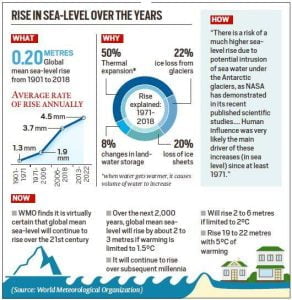Sea-level rise is a threat to cities like Mumbai, Dhaka, London, and New York, a report says.

A new report from the World Meteorological Organization (WMO) came out on Tuesday. It says that India, China, Bangladesh, and the Netherlands are the places where rising sea levels pose the most danger.
The report “Global Sea-Level Rise and Implications” said that the rise in sea level is a threat to a number of large cities on all continents. These cities include Shanghai, Dhaka, Bangkok, Jakarta, Mumbai, Maputo, Lagos, Cairo, London, Copenhagen, New York, Los Angeles, Buenos Aires, and Santiago.
“It’s a big problem for the economy, society, and people. The report said, “Rising sea levels threaten coastal farmlands, water reserves, the strength of infrastructure, as well as people’s lives and ways of making a living.” “Storm surges and changes in the tides make the effects of average sea-level rise worse, as was the case when hurricane Sandy hit New York and Cyclone Idai hit Mozambique.”
The WMO said that future estimates based on climate models and ocean-atmosphere physics make it hard to know how fast Antarctica’s largest ice mass will melt.
Even though sea level rise is not the same everywhere and varies from region to region, the report says that if it keeps going up and speeds up, it will “encroach on coastal settlements and infrastructure and cause low-lying coastal ecosystems to be submerged and lost.”

“If trends in urbanisation in vulnerable areas continue, this will make the effects worse and cause more problems in places where energy, water, and other services are limited,” it said. “Climate change will put more pressure on food production and access, especially in vulnerable areas. This will hurt food security and nutrition, and droughts, floods, and heat waves will happen more often, be stronger, and last longer. Rising sea levels will also make it harder for people to get food in vulnerable areas.”
WMO says that the number of people who could be affected by a 100-year coastal flood will rise by about 20% if the global mean sea level rises by 0.15 metres compared to where it was in 2020. If there is no change in population, a 0.75-meter rise in mean sea level doubles this population and a 1.4-meter rise triples it.
“Urban systems are important and interconnected places that make climate-resilient development possible, especially along the coast. Coastal cities and settlements are a key part of moving towards more climate-resilient development. In 2020, almost 11% of the world’s population, or 896 million people, lived in the Low Elevation Coastal Zone. This number could grow to more than 1 billion by 2050. These people, as well as the development and ecosystems around them, face increasing climate risks, such as rising sea levels.



